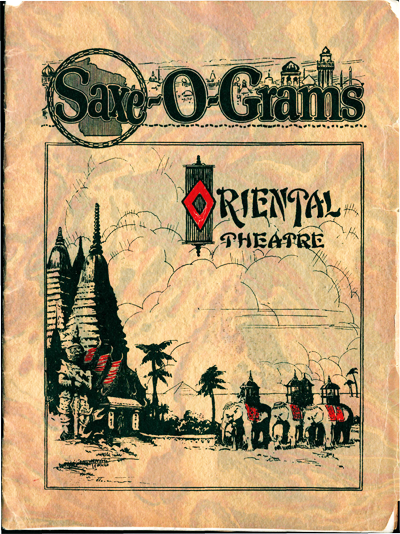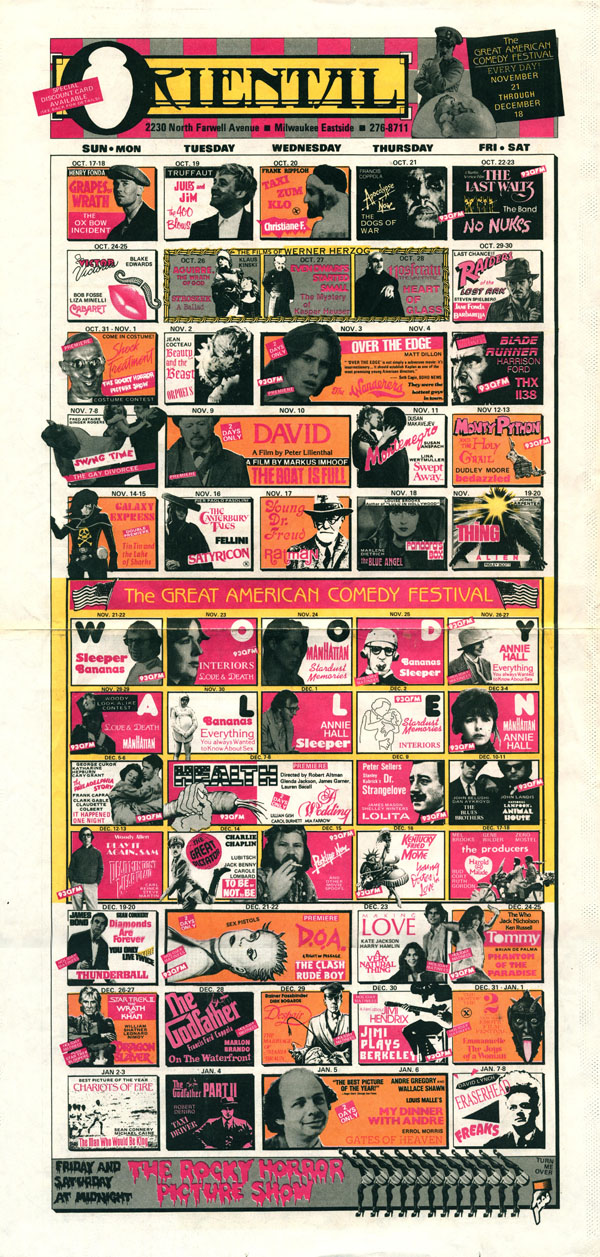90 Years of the Oriental Theatre From Saxe to Milwaukee Film
When John and Thomas "Tom" Saxe opened the Oriental Theatre on July 2, 1927, Milwaukee was a growing city of 536,400. Mayor Dan Hoan and Annexation Director Arthur Werba were in a middle of a 10-year campaign that increased Milwaukee's land area by 69% from 26 square miles in 1922 to 44 square miles in 1932 for middle-class residential development and industrial growth that was "Making Milwaukee Mightier."
 |
|
Opening Night Program. From the Milwaukee Public Library's collection. |
A year earlier, The Milwaukee Electric Railway & Light Co. (TMER&L, forerunner of We Energies and Milwaukee County Transit System (MCTS)) opened the first leg of the Rapid Transit line that was grade separated except for Downtown street running that would have been replaced by a short subway had the Great Depression not halted construction.
The circulation war between The Milwaukee Journal and William Randolph Hearst's Wisconsin News heated up from street corner fights between their paperboys to the new medium of radio as The Journal took to the airwaves with WTMJ (branded as "The Milwaukee Journal Station"). Not to be outdone, Hearst countered the following year with WISN (billed as "The WISconsin News Station"). The other two dailies, Hearst's Milwaukee Sentinel and the Socialist Party’s The Milwaukee Leader were a distant third and fourth in circulation.
The Saxe brothers operated Saxe Amusement Enterprises (Saxe AE), Wisconsin's largest movie theater chain in the 1910s and 1920s. They were the Marcus Theatres of their day. They opened their flagship theater, the 3,275 seat Wisconsin Theater at 6th and Wisconsin in 1924. More than two-thirds of local box office receipts in 1926 were collected at Saxe's empire of first-, second- and later-run theaters.
This made them a lucrative target of Hollywood studios wanting to enter the Milwaukee movie theater market. From the 1920s until the Paramount Decree in 1948, the Hollywood Studio System was a vertical integration of movie studios and theaters. Loew's theater chain owned Metro Pictures and bought Goldwyn Pictures and Louis B. Mayer's studio to form MGM, the largest studio in Hollywood's Golden Age. It boasted it had “more stars than there are in the heavens.” Paramount Pictures owned the Publix Theatres chain. RKO was the marriage of Radio Pictures and the Keith-Orpheum vaudeville circuits (Riverside Theater was built by the Orpheum Circuit).
 |
|
The Milwaukee Journal, July 2nd, 1927. |
The Saxe brothers embarked on bringing the Downtown movie palace experience to the neighborhoods. They built five palaces (Tower, Uptown, Plaza, Oriental, and Garfield) on streetcar lines. The Oriental is located at Six Points, where the Upper East Side 18th Ward and Lower East Side 1st Ward met, and the 10 Wells-Downer, 15 Oakland-Delaware and 21 North car lines intersected. Cars for the three lines were once housed at a carbarn from 1887 to 1917 on the site of the future theater, Oriental Pharmacy and Overlook on Prospect apartments.
It was not the first movie theater in Six Points. The much smaller 638 seat, fourth- or later-run Murray Theatre (1911-1952, renamed East in 1944) was at the southeast corner of Murray and Thomas, a block north of the Oriental on the 15 car line.
M. L. "Moe" Annenberg (father of TV Guide publisher and philanthropist Walter) owned the Oriental Theater Building and leased it to Saxe AE. He owned the Daily Racing Form and commercial and residential property in Milwaukee.
The local architectural firm of Dick & Bauer designed many of the Saxe theaters, including the Oriental and its "sister," the Tower, which still stands at 27th and Wells. They designed the 2,310 seat Oriental with an East Indian motif with Middle East minarets to conjure an exotic illusion for moviegoers in an era before jet travel. Some of the names of picture palaces reflected how theatrical illusion worked hand in glove with cinematic illusion on the big screen, Avalon, Egyptian, and Venetian.
The bill for opening night included stage acts preceding Naughty But Nice, a comedy starring Colleen Moore. The Roaring Twenties star was friends with Tom Saxe and visited his summer home at Trimborn Farm and popularized the Dutch Bob hairstyle that is now associated with the cult film icon Louise Brooks. It ended with a Felix the Cat cartoon, the most popular cartoon character before being eclipsed by Mickey Mouse when talkies arrived.
Even though the Oriental is now considered the crown jewel of the Saxe chain, it was primarily a second-run theater with the bill changing three times a week. Until the 1960s, movies would open at a Downtown theater for a week, occasionally longer on the "Ave." before moving to progressively less expensive second-to-12th run theaters in the "Nabes." From the Milwaukee River to 6th St., Wisconsin Ave. was lined with first-run theaters, Riverside (RKO), Warner (Warner Bros.), Majestic (Orpheum Circuit), Garden, Alhambra (Universal), Strand (Saxe), Wisconsin (Saxe's flagship) and Palace (Orpheum Circuit).
President John Kennedy once said "Change is the law of life." Only five months after the Oriental opened, the Saxe brothers sold their statewide 45 theater chain to the Wesco Corporation in December 1927, which quickly formed Midwesco to operate them. Barely a month later, Fox Film using its pioneering Movietone sound-on-film process to join the ranks of the major studios, bought Wesco in January 1928 and organized Fox-Midwesco to operate the former Saxe theaters.
The Oriental quickly branched out to offer occasional live entertainment. With a stage, orchestra pit, and six dressing rooms, plays, musicals, vaudeville, dances, and concerts have been performed for decades. So were operas and ballets that appealed to the silk-stocking crowd that lived east of Downer Ave.
 |
|
Marian Anderson, January 24th, 1958, Milwaukee Public Library, Art, Music & Recreation Manuscripts and Playbills Collection, Oriental Theatre. |
Fox Film struggled during the Great Depression and sold the former Saxe theaters back to the Saxe brothers in early 1933, the bottom of the Depression. The Saxes quickly realized they wouldn't be able to hold on to all their theaters. Within a few months, the Oriental fell into the hands of Moe Annenberg, who owned the building.
John Saxe concentrated on running the White Tower hamburger chain. Tom Saxe operated a much smaller chain consisting of the Garfield, Uptown, Modjeska, Princess, Mirth, and Tivoli from 1933 until his death in 1938 that was affiliated with Warner Bros.
During the 1940s, Warner Bros. ran the Oriental. In 1948, Orto Theaters bought the Oriental Theater Building from the Annenberg's family Triangle Publication and St. Cloud Amusement started operating the theater. In 1955, former WTVW-Ch. 12 (WISN) investor L. F. Gran bought the Oriental and Tower and formed Kent Theaters to run them. He lost them in foreclosure in 1959. The sister theaters became part of the Prudential Theaters chain until United Artists (UA) acquired the chain in 1968.
Electricians Bob, Emmett, and Mel Pritchett bought the Oriental Theater Building in 1972. UA's lease ended in 1974. Parallax Theatres (renamed Landmark Theatres in 1980) signed a lease in 1976 and turned it into a revival house showing classic, cult, foreign and silent movies on a repertory schedule that saw the weekly bill change more often than during the studio system days. The Rocky Horror Picture Show started its long continuing midnight ride in January 1978.
The Violent Femmes got their big break in August 1981 when Chrissie Hynde and John Honeyman Scott saw them play in front of the Oriental and invited them to open for The Pretenders in the evening.
 |
|
Oriental Schedule, October 17th, 1982 – January 8th, 1983, Milwaukee Public Library, Art, Music & Recreation Manuscripts and Playbills Collection, Oriental Theatre. |
By the mid-1980s, the VCR was cutting into the Oriental's trade. Landmark made the controversial decision to split the theater into a triplex to remain financially viable. They avoided massacring it as when the Centre (Warner) built a false ceiling to create separate theaters for the auditorium and balcony. Two smaller theaters were created in the auditorium underneath the Oriental's balcony. I liked sitting underneath the first few rows of the balcony when it was a single screen.
The Oriental became an art-house theater with a weekly bill. New Land Enterprises bought the building in 2004. Milwaukee Film started the Milwaukee Film Festival in 2009 and the Oriental became its main venue. On Sunday, news broke that Milwaukee Film signed a 31 –year lease to become the latest operator of the Oriental on July 1st, 2018.
Larry Widen, author of Silver Screens: A Pictorial History of Milwaukee's Movie Theaters was asked why the Oriental survived when the vast majority of neighborhood palaces and theaters closed at a book talk at the Central Library 10 years ago. He answered that the East Side has been fortunate not to suffer the economic decline that afflicted other neighborhoods. UWM's enrollment for more than four decades has been 10 times as large as its State Teachers College predecessor 90 years ago.
Six Points has evolved from a traditional neighborhood retail district symbolized by its heart and soul, the Oriental Pharmacy to a student bar-hopping scene for the past few decades to the recent spate of new apartment buildings (think The Standard above our East Branch) that whisper gentrification to some.
To find out more about the Oriental, Saxe chain, and other Milwaukee movie theaters, start with Widen's Silver Screens and Milwaukee Movie Theaters.
The Central Library's Art, Music & Recreation Department has a playbill collection of some of the stage acts at the Oriental from 1928 to 1964. Please call (414) 286-3071 to make an appointment to view them.
The Art and Humanities departments also have clipping files on the Oriental Theater. The latter can be viewed by calling Humanities at (414) 286-3061. While our Wisconsin Architectural Archive does not have the plans for the Oriental, it does have some Dick & Bauer plans, including Saxe's Garfield Theater, which still stands next door to our Martin Luther King branch. Call the Art Department to view architectural plans.
Thanks to movie theater researcher and library patron Hugh Swofford for additional information about a Milwaukee landmark.
The Oriental will celebrate its 90th anniversary a week early on Sunday with a screening of Casablanca at 7:15 p.m. A fitting choice, the Humphrey Bogart and Ingrid Bergman classic opened at the Warner in January 1943 before moving to a second-run at the Oriental in April.
Dan, Local History Librarian.
